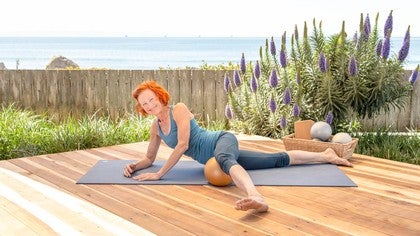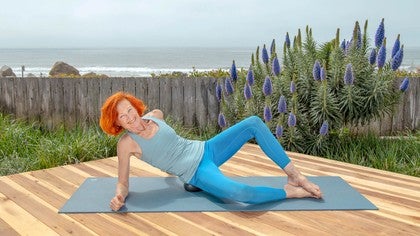Description
Props Needed: Black or Grey Yamuna USA® Ball, or something equivalent
About This Video
Transcript
Read Full Transcript
Welcome to today's class. It's actually a favorite area of mine because it's brought me so much benefit and improvement in my body, and it's been a miracle worker for some of my clients. We will be addressing basically this line right on the side of the body that runs down. Anatomically, there is a short muscle that runs from the top of the hip to the greater trochanter and it's called the TFL or tensor fascia latae. And it is a very important stabilizer for the pelvis.
Again, it is one of those muscles that if you have a hip that's higher or a leg that's shorter, it may be the culprit from the soft tissue perspective and changing and evening it out can really shift the balance of the pelvis. And I always had a problem TFL on my left side, I will demonstrate my point on the right side. And I was in a conference and I was asked to do tree pose and balance and this hip would always, I would always balance like this. You see lots of people doing this. They're throwing the hip way out to create a balance point, but the stabilizer is inactive and not working.
After I ran out or rolled out this muscle for the first time, I lifted my leg just circumstantially. And I'm like, "Oh my god, there it is." And I'm balancing and I'm safe and I can control my body. So big, fun change and transformation. It's also part of the hip flexor complex. And when we're sitting all the time or we have a pattern of crossing our leg one way, or we have a pattern of hiking into one hip, we don't stand evenly in time, the pattern of the body gets all torqued and distorted and it compromises our physiology and makes us more prone to injury, tiredness, fatigue, and less power in our lower body.
So we will start with this one and then move down to the IT band, which so many people always say, "I have a tight IT band," not realizing that what's really happened is the quads got glued in and or the hamstrings got glued in. So these muscles are all pulling on this band, which is a stabilizer and a spring light quality and a healthy muscle. So let's discover what's going on in your body. We will start with the TFL. I like to work with a harder, textured ball.
Yoga Tune Up balls are good, tennis balls are good, but they're not really that dense, lacrosse balls if want to be a pro and not an amateur. Feel around for the top of the ridge of your pelvis, that bony structure. Just to have a concept, we worked on the glute in another lesson, which is just a bit back. And now, we're working exactly on the side of the pelvis and it's a small fibrous area, almost like a triangle, you could say, that you want to get into and soften up and stimulate. So I'm placing the ball right at the top and then rolling over so I can get on top of this ball and find where can I sink in?
Make sure you're really on the side. And it takes a moment to find the spot. When you found it, you know you're there. The top leg, you can use it as a stabilizer. You can put it like this, you can put it like this.
The important leg is the bottom leg. This will be your inclination, but it's a hip flexor muscle among other things. And we want to lengthen that muscle out and ask it to be at its full range of movement so we can really roll out any stuck over-contracted adhesions and patterns in the muscle. Once you found your spot, just take a moment to have these micro movements forward and backwards to find where you have pain, tightness, holding patterns, and check to see that the leg is still long. I will sometimes move my pelvis forward and back just to dance into this area.
Once you feel you've gotten in really deep, drag yourself up, I'm pulling towards my head, staying deep and pressing the tissue downwards. So it lengthens and then it's pausing again (sighing) and checking that I'm really releasing down into the ball and not tightening up against it. So the muscle gets stretched and all the adhesions of the connective tissue and fascia soften. Again, micro movement backwards, micro movement forward, back right in the middle of it, having a look at the bottom leg and the body. Remember, even if your body's forward, you're in a contracted position, you're developing the length.
And now can you take the leg even more back? Oh, that opened up a whole other area of tightness. If you're moving your leg further back, please double check you're not doing it from your lower back. It has to come from the joint of the hip. The lower back should not be changing shape.
If you find you're pulling into the lower back, don't go there because you're faking it. We want that lower back long. And then we want to open what needs to be opened. Again, slightly rolling forward and backward. I am sure by now you're finding areas that are talking to you.
It can be wonderful. The first time can be very intense, perhaps. One more drag, deep, deep in this muscle, I can feel the top of my greater trochanter under my thigh bone now. So I'm in deep. If you're not sure, it's nice to take a deep breath in (sighing) and then sink, really, really down into the ball as best as you can.
Again, micro movements, rolling backwards and forwards. This is called cross fibering the muscle. If you feel an area that's really tight, trust it and hang out there and you will never be the same again, which is our goal. We want to get younger, looser, freer, more powerful, more comfortable in our bodies. Find a nice deep point, maybe an intense point in your muscle structure above the hip bone or the thigh bone, all these bones.
And now staying really sunk in, start to drag the knee forward. As the knee comes forward, sink deeper into the muscle. So we're separating the texture of the muscle from the muscles of the thigh and even the glutes. I can feel totally how my glute is having to open up because I'm not letting the muscle get short. So just move into that once or twice.
If you have a spot that's really tight, pause there and sink in. Remember you're moving right into what's dry, rigid, and no longer operational, and you want to bring it back into your full vocabulary. Moving up, moving down and just for fun, take a moment and lay yourself out and go even deeper and you can even if you want to lengthen the other leg up so you're fully sinking into the muscle and micro move there. Nice and long, sink one final time. Remember, all this work two minutes, five minutes, 10 minutes when it's serious and visiting it more than once will give you massive, massive dividends.
Rolling off, take a moment. Feel the leg, feel the joint. And let's move on to the other side. Again, feeling where is the top of my pelvis? Where is that bony structure?
It's usually higher than we think, finding the bone and moving a little bit onto the side, just below the top, literally. Once you're off the bone, that's where the muscle is attaching into the top of the pelvis and we want to get onto it and then start sinking down. Make sure you're right on the side of your own pelvis. Check the bottom leg. This is the leg that on my body, I always have to lengthen out a bit more because it tends to grip up.
Get that leg nice and long, get the pelvis long and then micro movements forward and back. And I don't know if you love me or you hate me now, but I hope you love me. (laughs) If not now, maybe later. (laughs) So back and forth, because again, this work can change years and years of patterns in like 10 minutes. And that's why I'm such an advocate of doing it because the change can be fast, the relief can be profound.
And guess what? It's you and the balls. So staying nicely sunk, check that the leg is long, And sinking into the ball, drag your body up a micro inch, sink into the ball again, check the bottom leg. So you want to roll and stay with the pressure in. If you notice I bringing my pelvis forward to get extra impact into this area.
I'm literally rolling right to the edge behind what would be the hipbone area, If you can feel that in your own body and then I'm rolling a little tiny bit back, back to the center, dragging a little bit more down and checking that bottom leg again, lengthening it out. Oh, beautiful stretch now coming into this area. It's opening up the whole front of my hip. It can feel wonderful. (laughs) And again, slightly rolling forward, rolling back, spending time where your patterns are talking to you so you can get really a lot of change.
You always have the option of going down as you do that. It actually intensifies the work and the pressure. So play around with your body position. You don't have to be doing my shape. You want to follow and explore your shape as much as possible.
Remember, you're staying on the side. One more time, dragging up a little bit further. Now I'm right at the top of my greater trochanter. Again, back and forth, greater trochanter meaning thigh bone, the big bone that runs down your thigh, only one bone. Ironically, would you believe it's only about this big .
Everything else is muscles and muscles and tendons. It's amazing how many layers we have in the lower leg area all to power us, to make us stand, walk, and all those areas can get glued up, the connective tissue can kinda glom up between the textures of the muscle and restrict the movement. And now here we go. I'm sinking into the ball and starting to bend and drag the knee forward. Huge release in the front of my hip when I do this, taking the leg back again and finding I can maneuver my body better with the leg bent again.
Oh, this side is more painful. So normally when I have a side that's more intense, I will do it first. (moaning) I just released a whole lot and then I will do the other side and then I will go back and do the side that's got more history in it, my second best side, as I like to call it, and really shift things around. By the way, I often do this work before I workout to open up the potential in my body. And then sometimes, I'll do this work maybe late at night where I feel really tight to get all the tension out of my body and be pain-free or really comfortable and relaxed to go to bed at night.
So the sky is the limit as to how you use it. Both legs out, final sink into the TFL. We love you. And then roll off, lie in your back, check your legs. What do they feel like?
What does this area feel like? Put your hands on your own hips. Do they feel different? Are they longer? Does the pelvis feel flatter?
Do the legs feel longer? Move them in the sockets. Do they feel freer? We want all of those qualities. We want to be open and long.
We want to anti-age. We wanna rise up and get further taller instead of shorter. Coming up, we have our famous DFL. So this has a lot of moving parts to it. I'm going to shift back to the black ball.
We ran through the TFL up here, and I'm sorry, and now our IT band, we're going to go maybe six inches down from the bulge or as high up close to the bulge as you possibly can be and then get yourself on the side. So we start up quite close to the top, make sure you're right on the side of your leg. And now see if you can roll down to, this is a bit tricky to get there. We want to get the hip on the ground. Whoa, takes a moment as you can see.
Get your hip on the ground so that the weight is digging right into that side of the leg. If you want to, you get both sides and just take a moment and let it sink. So this as well can be done with both a softer ball, the black ball tends to be softer, or a harder ball. You can even do a bigger ball once it starts to release because we're working a very interesting angle into the leg. So we're just gonna move slightly forward and back loosening up this area.
And then see if you can get the ball even higher. So I'm rolling over, seeing if I can get the ball right up close to the top of the hip and this time I'm bending the leg a little bit and coming up. There we go. Now I can feel I'm right on it and you can see saw the hip down. What happens when you see saw down and up like this is it stretches the leg downward.
It tractions that muscle towards the knee and creates the length that we want, and then slowly stretching the leg out. So a lot of length coming into this area. I'm going to roll up and down very slowly so that first six inch area, I'm massaging it, you could say, and now slowly dragging a little bit further down, checking as you do this at your right on the side can be active, it can be very intense and that the leg is going straight down. Moving a little bit further down, it can get more intense as you keep going. Take a moment to sink.
Every time, pause and check. Oh, I just released my muscles and the ball went a lot deeper towards the bone so a lot of the congestion starting to kick in. Moving a little bit further, every time pausing, relaxing into the muscle or holding it there and waiting. When the muscle is ready, it will start to give up. If it's too much in this way, you can always lighten the load this way so there's just a little bit less pressure.
I've even had people that can balance, get the top leg and press into it. If I'm working live with a client, I can take my hands and press this area down always with the intention of creating length. Let's move a little bit further down towards the knee. And one other very important point, check the line of the knee in relation to the hip. You don't want your knee rolled in or rolled out.
And if you have adhesions, they pull the knee in a direction and we're looking to unglue those adhesions not indulge in the pattern we had before. We want to up-level the patterns in our body. I'm still dragging a little bit further till I get all the way to the knee, nice and long, pressing into it and coming off. Moving to the other side. Remember, the first part is about six inches down just to start to open the energy up between these two points.
So taking the ball, figuring out how to have it long as high up close to the hip as you can get it with the hip down and hanging out here for a minute, starting to get that pressure into the IT band, very intense area for a lot of people. As you loosen up this area, it's going to start to give up the ghost and restore more elastic, willing participation in the experience of legs. (laughs) Now, this is a fun technique. You can actually push down to lift if you have that with you. And all I'm doing is showing you different techniques to kind of take it to the next level.
I've been rolling out my body for quite a long time intensively. So the body gets more and more receptive to the work as you keep doing it. You start where you are. You don't try to do more than you're ready to do, but you just indulge in it. And the body softens and youthifies and welcomes this work, and you will find your Pilates workout or any other workout you do better and better and better.
So softening up this area, coming off, moving up higher now. So right close to the top, rolling onto the side and now lifting the hip up. So now we're getting right to the top. Conceptually, we have this bone that goes out and then down. So we're just right close to the top bulge, sinking in and then checking if we can to get the bottom like nice and long.
I could just feel a huge stretch in the front of my quad as everything opened up and lengthened. Foot can be in front or in back. You can be further down, further up. Drag yourself a little bit upwards. I'm moving up towards my head.
The ball is moved down a bit. If you want to, you can be on your side. It's a bit of a balancing act. So (laughs) it's up to you. Then drag a little bit further.
When you drag, more important to check that you're relaxing. You're not tightening against the pressure, you're softening into it and move slow because the fascia has a few different qualities. It can be fibrous and it can be more taffy like, and we want to open up that taffy, stretchy youthful quality. If you move fast and you just try to pull through an area, you don't go deep, and you don't restore the elasticity, you actually irritate something. So slow movements, staying very present with where the pressure is in the dissipation of pressure because of the dissipation of resistance to the pressure, I should say, is what you're looking for.
So keep dragging yourself down. This side is different from the other side. You definitely have one side that will talk to you in a very different way from the other. Check that you're still on your side, because you may feel the adhesions of quads or hamstrings wanting to pull the texture of the muscle in a certain way. Keep going.
I'm going to start moving my hip down now, as I get closer. This is, in my case, not enough, so I'm coming back to being here because I like the pressure much more this way, moving a little bit further so I get quite close to the knee, lengthening this whole side out, oh, is that good and coming off. (moaning) And we have more. (laughs) The quads are this big band of a group of muscles. And the side part of the quads can get all glued together with this TFL muscle.
So we want to get that separation out so all the muscle can work independently. If you have an imaginary line right on the side, imaginary line right at the top and about a 45 degree angle in the middle, this is where we're going for. And it's like you're using this ball to push all of this forward and separate it from this. And you will know what I'm talking about as we go through this. So starting quite close to the top, maybe an inch or two below the top of the hip, lean in.
So you're just a hairline in front of your IT band. And you are pressing into the space between the quad and the IT band, so literally pushing the quad this way. So sink into it a bit. I like to drag and rotate. It's like I'm moving my body a hairline forward.
And then keeping this angle, lengthen the leg out and drag yourself a little bit further forward. I can feel a huge amount of heat being released right now in my body, so I know an area that did not have circulation is opening up, and gentle rolling forward to push the quad off the IT band back. So if you can see I've taken and I'm lengthening down a little bit more. Rolling that quad forward, it just released a bit. (moaning) And dragging a little bit further, rolling forward.
So I'm incrementally taking one little movement at a time, moving an inch down with the ball, rolling that quad of the IT band down. This can free up a lot of problems in the knee, by the way, rolling forward and rolling forward. One last time, rolling forward and off. (laughs) Other side, adventures. Always a muscle band, the two joints in between, problems here, problems here can be affected because of the connective tissue and it can have harmonics that are going down and up in the body.
So it's a very global impact that this work will have. Find your bone of your thigh, come a little bit forward. See if you can get just in front of the bone. So we're not on the side, not on the IT band, we're grabbing all of the tissue, we're rolling it forward. Sink into it if you want to and you can, lengthen the leg out to create that length, opening up all of this whole conglomerate that gets all grabbed and tight and holdy and fixed.
And we want it open and elegant. Roll a little bit down with the ball up with the body, roll into the quad. Drag that quad off the IT band. Come back, drag yourself a little bit further, relax. Make sure you're not gripping.
Take time when you're doing your own practice. Don't skip an area that's tight. Stay with it. It's more valuable to spend five minutes in one area that's grippy and tight than to skip it and just do the full muscle band, is actually true. And that's where you will personalize this practice for you, and you will never be the same again.
Oh, right here. Right here, I should spend five minutes, (laughs) but I'm not after I gave you all of my good advice. Rolling forward and back. I can literally feel this dragging my kneecap into a better place and back. And I've had some pretty severe knee injuries in my youthful days.
So thank goodness. This work means I can care for my legs and knees. And in spite of having a very athletic adventuresome youth, enjoy similar qualities in my older years. Rolling forward so I'm gradually moving down and rolling the quad in. Coming all the way up just above the knee one more time, this feels so good and coming off.
And we have more. (laughs) This one is a long one. We have our greater trochanter in our hamstrings. So the hamstrings too can get adhesions into this IT band, and we want all these muscle groups working as best they can separately. So you want to find just behind, kinda between your sit bone and the thigh, the back, so just behind the IT band.
This one is a little different because I'm actually getting my knee up and then I'm pushing in. And I'm using it to press... (moaning) There we go. As I've found the side of my bone, pressing in and rolling my hamstring there. Now it's pulling.
So I'm gripping the hamstring and dragging it away from the thigh, holding that tension and rolling down a bit. So it's literally pulling all of this tissue this way and I can feel the pressure pulling away from the IT band. Rolling a little bit more down. Now that I've caught that tissue really well, I'm just dragging it. I'm just slowly, slowly separating adhesions and glued up connected muscle fibers that gets stuck together.
There's no two ways about it. We live in a gravitational field. Parts of our body don't move all the time and they will get tight and they will get stuck. It just nature. It's just the world we live in.
It's not that anything's wrong with you. Every morning when you wake up, you're stiff because you didn't move. And opening up that texture and the stuck points in the body, opening up the connective tissue, that's why stretching can feel so good. That's why dogs and cats stretch after they've been lying down always. Humans almost stretch.
I always laugh. My dog will stretch before he comes and gets food and my cat. Humans will wake up in the morning and they go and make coffee first. They won't stretch. So we have like high end lifestyles that remove some of our base inclination.
So here we are. Here's my femur bone, the thighbone. I can literally dig in and feel it. This is where the IT band runs. So I'm finding the bone and now I'm rolling off of it and then positioning myself as high up close to the sit bone or the top of the thigh as I can wedge myself in.
You can even come up on the ball if that helps. And you can push down to get more of a leverage into this area. There is no one way you need to be positioned. You need to get that pressure in and then drag. And this side, I feel I get a lot more leverage.
Literally, I'm seesawing a little bit. I can feel the pull, roll a little bit further. There now the quad, not the quad, I'm sorry, the hamstring. I can feel it literally rolling off. Feels so nice.
Dragging a little bit further using the weight of the other leg now to get even further into it. If I lift my body, I'm getting more weight. This is another option, just very slightly lifting and lowering, dragging a little bit further, lengthening out towards the knee, lengthening all those muscle groups down and in the direction of the back of the leg to pull them off any congestion on the side. This can also free up a lot in the hips. Because again, if you have all these muscles glommed together, they tend to impact our joints to become rigidified and not as free to move as they should be.
Oh, so good. So I would like you to lie down, feel your legs, move your feet, notice if they have space. Do you feel that the legs are longer in the sockets? I hope you do. Let's come up and see what it feels like to stand.
Let's have you bend your knees, though, before you stand and see what it's like. Do the joint feel looser. Can you hinge a little bit deeper? So hip flection or tightness in the hips is not anything wrong unless you spend your whole day there. Are you getting closer to be able to have a full bend of the legs?
Maybe you'll noticing that there's more freedom in there. So let's have us come up. Take a moment and stand, just see what it feels like. Do you feel more length in the legs? If you bend your knees and pretend to sit in a chair and come up again, does it feel more freedom around the pelvis?
And now just take a few steps. Do you remember at the beginning, I mentioned how this whole band on the side as a stabilizer, that you should be able to hold the hip in place? So believe it or not, when we walk, these areas should be kicking in so the full shaft of the leg is working and powering you forward. Sadly, a lot of people end up by knee walking instead of from this full pelvis and down. So can you find a little bit of more of that in you?
I hope you can. I hope it's interesting. I hope walking feels completely different. I am sure it will help you Pilates workout or any other workout you do. Please share your comments on this lesson.
See you in the next one.
Release Your Fascia: with Niedra Gabriel
Comments
You need to be a subscriber to post a comment.
Please Log In or Create an Account to start your free trial.


















